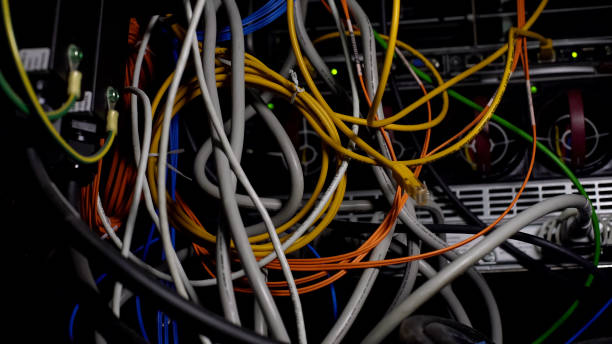
In today’s digital landscape, a reliable network infrastructure is vital for business success. Whether you’re a business owner or a network engineer, upgrading your data cabling can enhance performance and scalability. At Prime Data Cabling Services, we provide top-quality structured cabling solutions tailored to businesses across Toronto and beyond.
Data demands are surging with remote work, cloud computing, and IoT devices. Outdated cabling systems can cause slowdowns, downtime, and increased costs. This article explores key aspects of a data cabling upgrade, offering practical advice for a smooth transition.
Signs Your Cabling System Needs an Upgrade
Recognizing warning signs early prevents disruptions. Many businesses use legacy cabling unable to handle modern bandwidth needs.
Persistent network slowdowns or bottlenecks indicate an issue. Growing organizations add devices or users, overloading older cabling and reducing speeds. Lagging video calls or slow file uploads often point to inadequate cabling.
Physical wear and tear is another red flag. Cables exposed to moisture, heat, or damage degrade, causing signal interference or failures. Inspect for frayed wires or outdated terminations.
Frequent downtime or connectivity issues suggest a need for a network cabling upgrade. Electromagnetic interference (EMI) or crosstalk in older cables can cause outages. Upgrading to shielded or fiber optic cables mitigates these problems.
Business expansion, like adding new floors or high-bandwidth applications, may overwhelm existing systems. Non-compliant cabling with standards like TIA/EIA can also pose risks during audits.
Key signs include:
Slow data transfer during peak usage.
Visible cable damage or outdated types (e.g., Cat5).
Increasing network diagnostic errors.
Inability to support technologies like VoIP.
Addressing these promptly saves time and money.
Benefits of Upgrading Your Data Cabling
A network upgrade offers benefits beyond immediate fixes. It enhances efficiency, cuts costs, and future-proofs your business.
Improved Network Performance and Speed
Upgrading to Cat6A or fiber optics boosts data speeds. Cat5e supports 1 Gbps, while Cat6A handles 10 Gbps over longer distances. This ensures faster file sharing and smoother cloud access.
Fiber optic upgrades offer up to 100 Gbps and resist EMI. Reduced latency improves user experience and productivity.
Enhanced Scalability and Future-Proofing
A modern cabling system grows with your business. Scalable setups accommodate new devices, integrating technologies like 5G or smart systems without major overhauls.
Proactive upgrades prevent obsolescence. Businesses report fewer disruptions during expansions with flexible cabling.
Cost Savings and Reliability
Upfront costs are offset by long-term savings. Modern cabling reduces energy use and maintenance needs. Fewer failures mean less downtime, which can cost thousands per hour.
Reliability is critical for sectors like healthcare. Upgraded systems offer better warranties, ensuring peace of mind.
Security and Compliance Improvements
Outdated cabling risks data leaks due to poor signal integrity. Upgraded systems with better shielding enhance security. Compliance with standards like ISO/IEC 11801 avoids penalties.
Types of Cabling Systems for Upgrades
Choosing the right cabling system depends on your needs and budget.
Copper-based cables like Cat5e, Cat6, and Cat6A are cost-effective and easy to install. Cat6A supports high-speed Ethernet and PoE for devices like IP cameras.
Fiber optic cabling excels in long-distance or high-interference settings. Single-mode fiber suits vast networks, while multimode works for shorter runs. It offers speed, security, and longevity but requires expertise.
Hybrid systems combine copper and fiber for versatility. Ruggedized cabling suits harsh environments like warehouses.
Consider distance, bandwidth, and future needs when selecting. Site surveys help determine the best mix.

Planning Your Network Upgrade
Effective planning ensures a smooth upgrade. Start with an infrastructure audit.
Map existing cables, identify bottlenecks, and check compatibility. Cable testers reveal hidden issues.
Define goals: bandwidth needs, user count, and budget. Factor in materials, labor, and downtime costs.
Engage IT teams and management to align with business goals. For complex projects, consult experts for customized designs.
Plan timelines to minimize disruptions, like upgrading one floor at a time. Ensure compliance with safety standards using certified technicians.
The Upgrade Process: Step-by-Step
A structured process ensures minimal disruption during a network upgrade.
Preparation and Design
Create blueprints for cable routing and termination points. Use software to simulate performance.
Procure high-quality materials from reputable suppliers to ensure reliability.
Installation and Implementation
Technicians pull cables, terminate connections, and label them for maintenance. Precise splicing is critical for fiber optics.
Integrate with existing systems carefully to avoid outages. Test at each stage for functionality.
Testing and Certification
Post-installation, use tools like Fluke DSX-8000 to verify performance. Certification ensures compliance and provides warranty documentation.
Maintenance and Optimization
Regular inspections and monitoring tools prevent issues. Updates keep the system optimized.
Cost Considerations for Data Cabling Upgrades
Costs depend on project scope. Understanding factors aids budgeting.
Material costs vary—fiber optics are pricier but offer better ROI. Labor, especially for certified technicians, ensures quality but adds expense.
Small offices may cost a few thousand, while data centers run higher. Hidden costs include downtime and training.
Competitive quotes balance quality and affordability. Long-term savings come from efficiency and reduced repairs.
Conclusion
Upgrading your data cabling boosts performance, scalability, and reliability. Recognizing signs, understanding benefits, and following a structured process ensures success. Whether choosing Cat6A or fiber optics, the right system future-proofs your operations.
Contact Prime Data Cabling Services, we guide you with expert installations and maintenance across Toronto and Canada.
Frequently Asked Questions (FAQs)
When should I consider a data cabling upgrade?
Upgrade if you face slow speeds, outages, or plan expansion. Legacy systems like Cat5 can’t handle modern demands.
What is the difference between Cat6 and Cat6A cabling?
Cat6 supports 1 Gbps over 100 meters; Cat6A handles 10 Gbps with better shielding for high-performance networks.
How long does a network upgrade take?
Small offices take days; large projects may span weeks. Phased approaches reduce downtime.
Are fiber optic upgrades worth it for small businesses?
Yes, for high speeds or interference-prone settings. Copper like Cat6A is often sufficient for many.
What standards should my cabling comply with?
Aim for TIA/EIA-568 and ISO/IEC 11801 for reliability and compatibility.